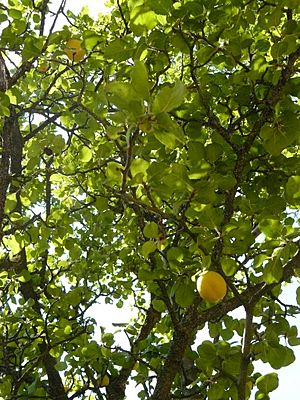Bear's plum facts for kids
Quick facts for kids Bear's plum |
|
|---|---|
 |
|
| Prunus ursina in Horsh Ehden reserve, Lebanon | |
| Scientific classification | |
| Synonyms | |
|
The Bear's Plum (Prunus ursina) is a type of plum tree. It grows naturally in the forests of Western Asia. You can find it in countries like Turkey, Syria, the Palestine region, and Lebanon. Some people also call it by its Arabic name, Arabic: خوخ الدب.
Contents
What's in a Name?
The scientific name for this plant is Prunus ursina. The word Prunus comes from Latin and Greek. It simply means "plum tree." Ursina comes from the Latin word "ursus," which means "bear." So, "Bear's Plum" means it's a plum that bears love to eat!
What Does Bear's Plum Look Like?
The Bear's Plum can be a large bush or a small tree. It usually grows about 4 to 8 meters (13 to 26 feet) tall. It has many branches, and some of them might have sharp spines. The young branches feel soft and velvety. Its leaves are shaped like eggs or are longer and oval. In spring, the Bear's Plum produces white flowers. These flowers grow in pairs. The fruit is round and about 2 to 3 centimeters (1 inch) wide. When ripe, it changes color from yellow to dark orange. The fruit is not tasty for humans. Eating too much of it might make you sick.
How Is Bear's Plum Used?
People can use parts of the Bear's Plum to make natural dyes. The fruit can create a dark grey or green color. The leaves can be used to make a green dye.
Important Safety Information
Plants in the Prunus family, including Bear's Plum, contain special chemicals. These chemicals are called amygdalin and prunasin. When these chemicals mix with water, they can create a tiny amount of hydrogen cyanide. Hydrogen cyanide is a chemical that gives almonds their unique smell. It is mostly found in the leaves and seeds of the plant. You might notice a bitter taste if it's present. Usually, the amount of this chemical in the fruit is very small. It's not enough to cause harm. However, you should never eat any very bitter seeds or fruits from wild plants. Eating small amounts of hydrogen cyanide can sometimes help with breathing and digestion. But eating too much of it can be very dangerous. It could cause serious breathing problems. Always remember: it's best not to eat wild plants unless an adult who knows them well says they are safe.
Growing Bear's Plum Trees
Bear's Plum trees grow best in sunny places. They can also grow in partial shade. If the shallow roots of the tree get damaged, new shoots called "suckers" might grow up from the ground. Like other plum trees, Bear's Plum can be affected by certain pests. One common problem is a type of fungus called honey fungus. If you want to grow a Bear's Plum from a seed, it needs a special treatment. The seed must be kept cold for two to three months. This helps it sprout.

